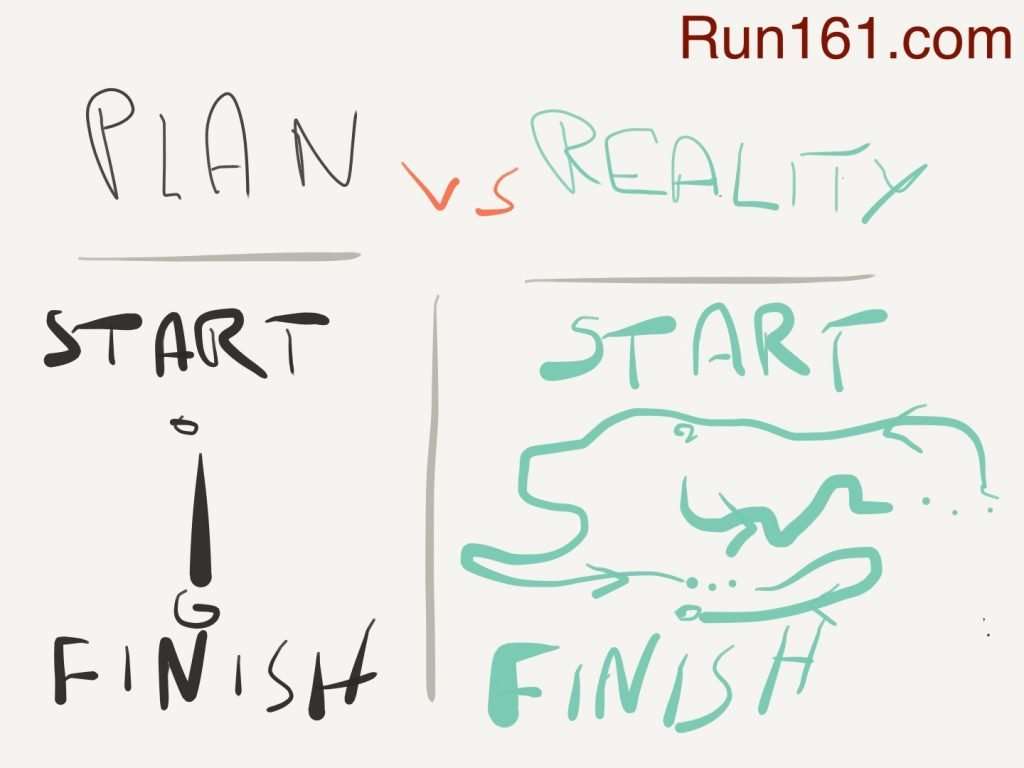Deciding whether being tough is being smart is a challenge for all runners. All the same, balancing running training and rest is key to your progress.
When Things Don’t Go According to Plan
After twelve weeks of marathon training going as planned, this week was supposed to be the making of me. The plan called for a hard workout, a very challenging long run and peak weekly mileage.
On the first day, I hit my first roadblock. On my Monday morning recovery run, I felt a niggle in the backside of my left leg. Best to be smart and drop my planned double that evening, I thought. The workout the following day would reveal if the niggle spelt trouble.
The workout the next day was anything but smooth. Stomach troubles left me unable to get through the session as planned. My leg was all good, though, so at least I was ready to crush the rest of the week.

Fast forward two more days, and I wake up feeling a bit off. It’s nothing major, but I’m a little bit shaky and lightheaded. On the schedule for the morning is my midweek medium-long run. If I stay in, my training week already feels wasted. I’ll be way off my target mileage, and none of the midweek sessions will have gone as planned.
Do I push through, or do I take a step back and rest for the day?
Every runner will find this situation familiar. And it feels like a no-win situation. Either you tough it out with a real risk of aggravating whatever’s bothering you, or you capitulate. Because, to most runners, dropping a run feels like taking a loss. It is admitting defeat.
In most cases, this aversion to deviating from the plan is what makes us progress. A little wind, or rain, or snow won’t stop us from getting the job done. We are runners, and run we do, ticking the boxes as we go along towards our dreams of running faster and longer.
That’s not to say that the right call every time you feel a bit down is to skip a run. If I only ran when I felt good, I wouldn’t be much of a runner. The tricky part is, of course, knowing when to adjust your planned run, or even take a full rest day.
Points to Consider When Balancing Running Training and Rest
It can be helpful to take a step back and look at the bigger picture when trying to determine whether to push through or dial it down. By getting caught up in the single-minded focus on getting through what’s on the schedule, we often lose sight of what matters.
The following pointers have been helpful to me in determining the appropriate course of action in situations like these.
Are you tired, or coming down with something?
Knowing your body well enough to distinguish general tiredness from something more sinister is an essential skill. Being tired is not a reason to skip a run. To the contrary, stacking long runs and workouts while you are tired is a critical component of most training plans. The cumulative fatigue that builds throughout a training block increases endurance and strength in a way that no workout can do on its own.
Separating this tiredness from something else, like a bug or a virus, can be difficult. It is crucial, however, because you do not want to run hard when coming down with something. Doing so will cause further setbacks, compared to appropriate rest.
Ask yourself these following questions to decide whether a rest day is in order:
- Are you lightheaded or even dizzy? Don’t spring for a workout. Rest or at most an easy day is in order.
- Do you have a fever? Don’t run. Rest and sleep as much as you possibly can.
- Have you come down with a cold? See the above pointers. Additionally, you do not want to strain if you’re coughing up phlegm from below your throat. I’ve found that easy runs are OK as long as it’s just a cough.
Niggles are part and parcel of running
Being a runner involves discovering new parts of your body you never knew of through pain. This pain is not the screaming and yelling variety, though, but rather the dull ache that characterises a niggle.
Resting every time we feel a niggle is not feasible. Most of us wouldn’t get much running done if we did. Instead, to progress as runners, we have to learn to run through a bit of pain. The nature of a niggle is fickle, and what hurts one day may well be gone again the next. Properly balancing running training and rest means knowing what to run through, and what necessitates rest.
If it hurts enough to sideline you, get it checked
Unlike niggles, full-fledged injuries are not something you can run through. Once something hurts to the point that you are having trouble running, you should not attempt to run through it. Likewise, if the pain is severe enough that you have to alter your gait, you need to rest.
Another thing that separates an actual injury from a minor niggle is the fact that injuries rarely disappear overnight. Unfortunately, too many runners rely on the body to deal with injuries on its own.

In most injury cases, there are many things a runner can do to minimise time out. Similarly, some cross-training may be advisable to minimise loss of fitness. However, you need qualified guidance to know the appropriate course of action to handle a running injury.
If an injury keeps you from running more than a few days, my advice is to schedule a meeting with a professional. Getting the correct diagnosis, and a qualified plan to get you back to running is simply a must. A recent study showed that even corresponding with professionals online can reduce and prevent injuries. And, let me reiterate for clarity: Don’t try to run through an injury!
Consider your goals
When deciding whether or not rest is in order, your running goals should always come into consideration. How close you are to race day, and where you are in your training plan, matters.
The closer you are to race day, the less risky your decisions should be. Other than the satisfaction of getting the job done, there is very little to gain by pushing through. The potential damage if you do get it wrong, however, is far worse than a couple of days off.
As race day approaches, recognise that you have done the bulk of the work. The hay is in the barn, so to speak, and now is the time for caution. Do not risk turning a two-day bug into a week without training, just because it feels nice to get in the miles.
Long term consistency is king!
A session may appear pivotal as you approach it. A good runner, though, recognises that no single workout makes or break your fitness. Consistency over time, in mileage and workouts, determines your shape.
It is easy to lose track of this as we face the possibility of having to drop a planned session. In these cases, I try to shift my perspective from focusing on that single week, to instead consider my long term progression.
If I go through with the planned workout, will it add to my consistency? Or am I more likely to aggravate whatever’s bothering me, and potentially miss out on further sessions? If the expected cost of one run is several more runs missed, you are better off adjusting your plan.
Adjust or rest?
Sometimes a halfway solution can be tempting. Instead of going through with a hard long run or workout, you opt for a recovery run instead. This way, you give your body some space to recuperate, while simultaneously hitting your mileage goals.
Prioritise rest when rest is necessary, and you will find yourself back to normal quicker than with halfway solutions.
While I recognise that this may be a workable solution in some cases, I am not a big fan of it. If I’m feeling bad enough that I can’t go through with a planned workout, I instead focus everything on getting back to full fitness as soon as possible.
A runner’s goal should not be to run a certain amount of miles over a particular period. Instead, focus on maximising consistency and long term improvement. Prioritise rest when rest is necessary, and you will find yourself back to normal quicker than with halfway solutions.
One exception from this general rule is if you are returning from injury. In these cases, you often have to get through easy runs without pain before you can progress to workouts.
Knowing Your Body is Key to Get the Balance Right
To summarise, the key to balancing running training and rest is knowing your body. The only way to acquire this familiarity with your physical capabilities is through trial and error. It takes time, and you will probably get it wrong a few times along the way. Hopefully, the pointers outlined here will help you get it right more often than not.
And, as for me, I sacrificed another day of training for full rest. However, waking up the next morning and still not feeling entirely well, I said enough is enough and went for a run.
I felt the best I had done all week.
Like this?
Let me know by sending me an email at lc@run161.com.
